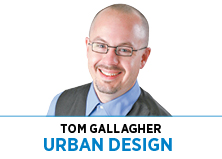Subscriber Benefit
As a subscriber you can listen to articles at work, in the car, or while you work out. Subscribe Now As hard as it is to fathom life without them now, urban freeways are relatively new. Consider that the last section of Interstate 465 was completed in 1970; I-65/I-70 through downtown wouldn’t open for another six years. Yet, in less than a generation, few developments have had such a big effect on the economic and social life of our city.
As hard as it is to fathom life without them now, urban freeways are relatively new. Consider that the last section of Interstate 465 was completed in 1970; I-65/I-70 through downtown wouldn’t open for another six years. Yet, in less than a generation, few developments have had such a big effect on the economic and social life of our city.
To the extent the interstate system has achieved the high-minded ideals of personal mobility and opportunity, it has come at a high price. In urban settings, highways are dividers. They separate our neighborhoods physically and socially. With hindsight, we know them to be disruptive, if not altogether destructive, of traditional and historic urban fabric and downtown economic value.
Now that existing highway infrastructure is reaching the end of its safe and useful life, cities are confronting some tough questions. Most poignantly, they’re facing the prospect of spending billions of dollars on transportation networks in the very near future. Is highway repair, reconfiguration and expansion a worthwhile investment that promises returns or only more of the same? There are cities across the nation and the world that are answering that question with “no,” and the results are hard to ignore.
First, several studies now exist that demonstrate highway congestion is not a problem we can build our way out of. The most notable of these was published in 2009 by economists Gilles Duranton and Matthew Turner while they were with the University of Toronto.
They investigated the relationship between the number of lanes and vehicle-kilometers traveled on metropolitan-area highways throughout the United States from 1983 to 2003. What they found was that “the extension of most major roads is met with a proportional increase in traffic.” In other words, “new roads create new drivers, resulting in the intensity of traffic remaining the same.” Borrowing a term from economics, they cite “induced demand” as an explanation for the phenomenon. Like building a larger closet is apt to increase spending to fill it up again, we all have likely experienced a congested highway soon after the addition of lanes.
The second is even more surprising than the first and is best understood by illustration. In 1973, still in the height of the highway-building era, a portion of the West Side Highway in New York City collapsed. After the initial shock of the event, traffic engineers observed the unexpected. Ultimately, the city’s street grid was more effective at dissipating the traffic than was the separated highway. Drivers found new routes and the traffic was no worse for the loss. Politics delayed replacement of the highway and time proved it unnecessary. A new urban boulevard was put in place in 2001 and is credited with instigating the revitalization of the Chelsea, Tribeca and Meatpacking District neighborhoods.
Similar outcomes have been observed in Boston, Portland, San Francisco and Milwaukee, all of which have removed highways from their urban cores.
In the end, human beings are driven more by experience than by efficiency. No matter the route, we are likely to spend time in traffic in popular locations. So, grand boulevards like the Champs-Elysees in Paris, often as many as 10 lanes wide, are purposefully designed to be beautiful, emblematic and memorable places that define the experience of the city. More important, they are accessible by people of all ages, social-economic backgrounds and modes of transport.
One of the most iconic boulevards in the United States, the Rose Kennedy Greenway in Boston, is a 17-acre linear park along a 1.5-mile corridor that once was an elevated highway that split the city at its core. Many know this project as the “Big Dig” and are likely aware of it more for the highly publicized troubles, mostly endemic to being the first mega-project of its kind. Given the successes in other cities, one wonders if the highway tunnel below the park was an unnecessary cost.
In any case, more than 10 years after its completion, even the citizens of Boston recognize that the Greenway does for the city what an elevated highway could never do. It is a connector of people and neighborhoods. Not only has it significantly increased the value of adjacent properties, it has helped increase the value of Boston in hearts and minds beyond the city.
For Indy, the situation is no longer a theoretical one, as the Indiana Department of Transportation has released preliminary plans for the reconfiguration and expansion of the local leg of I-65/I-70, the so-called “north split.“ Numerous civic-minded organizations and talented designers have rallied together, calling for a more humane and 21st century response to our urban transportation infrastructure.
You can learn more, starting at the website for Historic Urban Neighborhoods of Indianapolis, huniindy.org, which has a summary document with project analysis and potential alternatives. Additionally, John Norquist, the mayor of Milwaukee who championed the 2003 teardown and subsequent redevelopment of the Park East Freeway, will speak at Indiana Landmarks on Feb. 26.
It’s time for Hoosiers to learn from what other thoughtful cities are doing and reverse, not double-down on, the destruction our downtown freeways have caused.•
__________
Gallagher is a principal and urban designer with Ratio and a professor-in-practice of urban design at Ball State University. Send correspondence to [email protected].
Please enable JavaScript to view this content.
